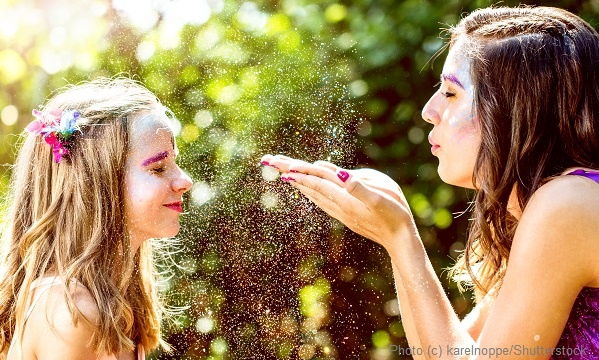|

The Glow is Coming Off Glitter
by Wendy Priesnitz
As the holiday season approaches, the outlook is glittery. Everything from Christmas cards and wrappings, to decorations, clothing, and cosmetics glows with those tiny gold and silver bits of glitter.
Unfortunately, these sparkles have a dark side: Glitter is bad for both our environment and our health.
Most glitter products are made from plastic, which contributes to the growing problem of microplastics in the marine environment. Microplastics include the microbeads found in cleansers and even some toothpastes, as well as microfibers in some clothing. Glitter is also a microplastic and compounds the problem when it is also found in cosmetic products marketed to girls and women.
When glitter and other microplastics are washed down the drain, they are consumed by plankton, fish, and birds. Those beings can die from starvation when the microplastics accumulate in their systems. Microplastics can also have a detrimental effect on human health as they make their way up the food chain; most glitter is made from a type of plastic called PET (polyethylene terephthalate), which, when it breaks down, can release chemicals that are human hormone disruptors. In addition, microplastic particles attract inorganic and organic chemicals to adhere to them, such as PCBs, which were banned decades ago but persist in the environment.
To make things worse, most glitter gets its sparkle from a layer of reflective material, such as aluminum foil. Aluminum is known to accumulate in the kidneys, brain, lungs, liver, and thyroid where it competes with calcium for absorption. In infants, this can slow growth. Research using animals has also linked aluminum exposure to mental impairments, including dementia.
Since glitter is wildly popular with many little children, some concern has been expressed about the danger of getting craft glitter in the eyes where a small particle of the sharp-edged plastic can scratch the eye and possibly cause infection. (Cosmetic glitter, on the other hand, is reportedly round-edged.) Also, if enough glitter is in the air, it could also be inhaled and cause a sinus infection or worse, according to some doctors.
As a result, some scientists and campaigners are calling for a total ban on glitter. The UK seems to be taking the lead with a 2018 ban on microbeads, which included glitter. Over 60 music festivals in the UK are banning the wearing of glitter at their events, and some companies have committed to completely removing glitter from their products.
As consumers, many of us know that we need to choose more non-toxic, environmentally-friendly products. However, that can be difficult if such alternatives are not available. A biodegradable, plastic-free product called “bioglitter” is one such alternative that has been developed by a small UK company. It’s reportedly made from eucalyptus tree extract and is aluminum-free.
If you already have glitter in your life, or it comes into your home along with holidays gifts, definitely do not wash it down the sink. Could you at least try to reuse it for future craft projects?
The only way not to add glitter to the already massive global microplastic problem is to opt for an eco-friendly alternative. I’m sorry to seem to be taking some of the shine out of your and your family’s celebrations, but with some research and imagination, you’ll discover that our lives don’t have to be less sparkly in order to be more environmentally friendly!
Wendy Priesnitz is the founding editor of Natural Life Magazine, and a writer with over 45 years of experience.
|

